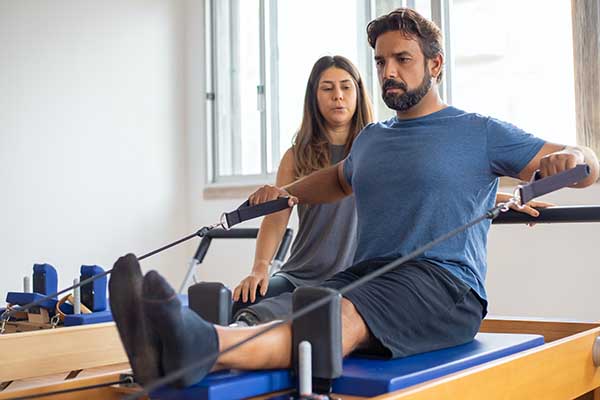When it comes to physical therapy (including physiotherapy, kinesiology, chiropractic etc…), two terms you'll often hear are active therapy (or active treatment) and passive therapy (or passive treatment). These terms describe your level of participation during treatment as the client.
Both active and passive therapy have an important role in your recovery journey, but how do you know where to start? And how can you be sure your health team is using the appropriate treatment? Which is better?
I’ll answer these questions below from my perspective running our kinesiology practice at Symmetrix. We’ve been treating clients for over 30 years and helped thousands of clients through active therapy with kinesiology in collaboration with therapists offering passive treatment.
Passive therapy refers to treatments where the therapist administers care while you remain relaxed i.e. passive
In passive physical therapy you are being treated without actively participating in the movement. Passive therapies are where most clients start in their health and rehabilitation plans, particularly for managing acute pain or injuries and preparing you for the demands of active therapy.
The most common examples of passive treatment are:
Passive Physiotherapy Techniques
Such as dry needling (IMS), manual tissue manipulation, ultrasound, and electrical stimulation. These treatments help relax muscles, manage pain, reduce inflammation, and restore function.
Chiropractic Care
Chiropractors use hands-on spinal adjustments and joint manipulations to relieve pain. Techniques like Network Spinal target the nervous system and are also passive.
Massage Therapy
Registered Massage Therapists (RMTs) use hands-on manipulation of soft tissues to relieve pain, improve circulation, and promote relaxation.

Acupuncture
Involves inserting thin needles at specific points in the body to treat various health conditions. It’s completely passive as you remain still during the procedure.
Consider Passive Treatments for Acute Injuries, Quick Pain Relief and in combination with Active Therapy
Passive treatments are ideal for:
- Acute injuries: Such as fractures or severe strains where movement could worsen the condition.
- Quick pain relief: For muscle spasms or inflammation where rest and targeted treatment speed up recovery.
- Progression to active therapy: Passive therapy works well in combination with active therapy to help alleviate some temporary increases in discomfort when returning to activity.
As you can tell from this list the common thread for passive therapies is they offer short-term relief, and support healing. What we see at our clinic is that passive therapy is most effective when combined with active treatments as you progress in your recovery.

Active therapy requires you to move and engage your muscles
In active treatment you perform exercises or activities that promote healing, improve strength, and restore mobility. Active therapy plays a vital role in long-term rehabilitation and functional recovery. Examples of Active Therapies:
Active Physiotherapy
Involves patient-performed exercises. Physiotherapists may provide 'homework' exercises to continue progress between sessions.
Kinesiology
Kinesiology focuses on human movement, biomechanics, and strength training. Kinesiologists guide you through personalized exercise programs and progressions to restore range of motion, improve posture, and enhance physical function.

Aquatic Therapy
Conducted in a pool, allowing clients with limited mobility to perform exercises with less strain due to the water's buoyancy.
Therapeutic Yoga
A gentle, holistic approach combining breathwork, meditation, and movement for physical and mental well-being.
Clinical Pilates
Guided by a physiotherapist or kinesiologist, this method emphasizes core strength, posture, and controlled movements, ideal for injury recovery and prevention.

When to Consider Active Therapy
There are many situations where Active therapy will offer the highest payoffs including kinesiology. Active therapy is beneficial when:
- Transitioning from acute injury recovery - Introducing controlled movement accelerates healing and increased confidence as well as tolerance to movement and exercise.
- Restoring functional abilities -For clients aiming to return to sports, hiking, or daily activities.
- Managing chronic pain - Active participation in rehabilitation can help break pain cycles and improve overall quality of life.

Active vs. Passive Therapy: Which is Better?
There’s no one-size-fits-all answer. The best therapy depends on:
- Severity of the condition: Acute injuries may require more passive care initially, while chronic issues often benefit from active interventions.
- Treatment goals: Quick pain relief or long-term functional improvements?
Modern rehabilitation trends favor active therapy due to its effectiveness in promoting long-term recovery. Facilities are shifting towards gym-based spaces where kinesiologists and physiotherapists collaborate, blending active and passive methods.
[[cta-kin]]
Counseling: The Mental Side of Rehabilitation
Rehabilitation isn’t only physical. Counseling plays a crucial role, especially when addressing chronic pain. Pain is influenced by physical, psychological, and social factors. Counseling offers a safe space to address these aspects, supporting mental resilience and improving recovery outcomes.
Final Thoughts
Both active and passive therapies have their place in recovery. Passive treatments provide essential initial care and pain relief, while active therapies ensure long-term improvements and functional recovery. Kinesiologists, working closely with other health professionals, help bridge the gap from passive care to active movement, guiding clients through tailored programs that promote strength, mobility, and overall well-being.
If you’re ready to learn more about active therapies and how kinesiology can support your health journey, make sure to check out the Ultimate Guide to Kinesiology.









